Plums Chart Pattern
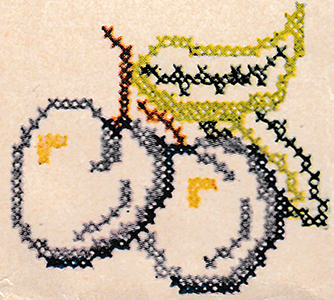
Pattern includes 11 fruit motifs: peach 3¾ x 3¾ inches; pear 3⅜ x 4¼; orange 3¾ x 4¼; cherries 4⅜ x 4¼; grapes 4¾ x 4½; strawberries 2¾ x 3; pineapple 4 x 8⅛; lemon 3 x 3⅝; plums 3⅜ x 3¾; apple 3¾ x 4¼; and bananas 4⅜ x 4¾. A chart for placing the colors and diagrams showing how to arrange the motifs on lunch cloths, table cloth, runner and luncheon set are also included.
This colorful fruit design for cross stitch makes a charming decoration for lunch cloths, runners, lunch sets, table cloths, curtains and slip covers for chair backs. The 10 to the inch crosses are suitable for six strand cotton.
Suggested Materials—Linen, cotton with a linen finish, cotton broadcloth, percale, gingham, and unbleached muslin are suitable materials. The diagrams in the pattern show the pieces made of 36-inch material. The large cloth can be made of 36, 54 or 72-inch material.
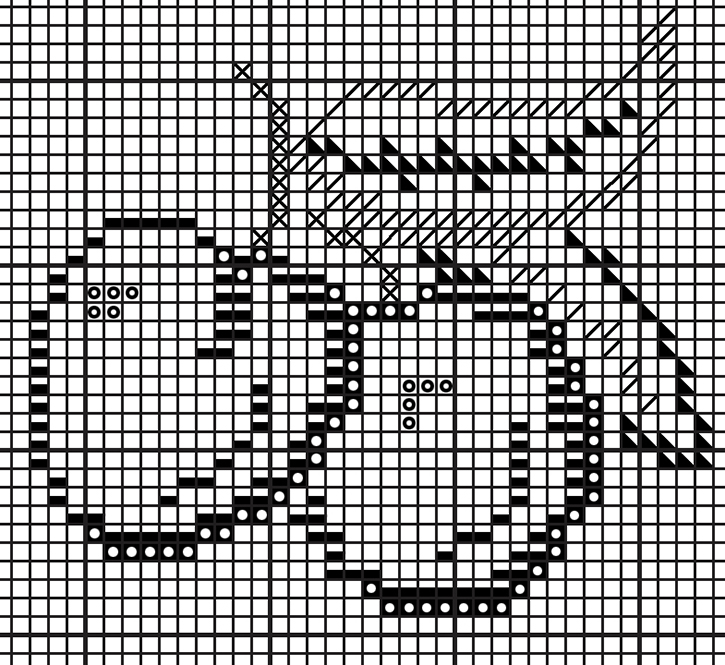
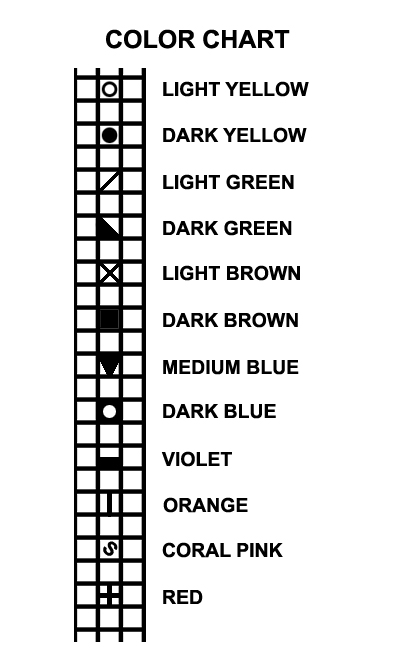
Pear Chart Pattern
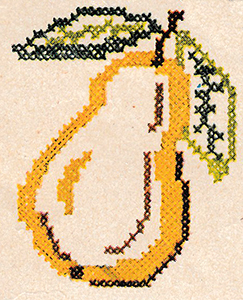
Pattern includes 11 fruit motifs: peach 3¾ x 3¾ inches; pear 3⅜ x 4¼; orange 3¾ x 4¼; cherries 4⅜ x 4¼; grapes 4¾ x 4½; strawberries 2¾ x 3; pineapple 4 x 8⅛; lemon 3 x 3⅝; plums 3⅜ x 3¾; apple 3¾ x 4¼; and bananas 4⅜ x 4¾. A chart for placing the colors and diagrams showing how to arrange the motifs on lunch cloths, table cloth, runner and luncheon set are also included.
This colorful fruit design for cross stitch makes a charming decoration for lunch cloths, runners, lunch sets, table cloths, curtains and slip covers for chair backs. The 10 to the inch crosses are suitable for six strand cotton.
Suggested Materials—Linen, cotton with a linen finish, cotton broadcloth, percale, gingham, and unbleached muslin are suitable materials. The diagrams in the pattern show the pieces made of 36-inch material. The large cloth can be made of 36, 54 or 72-inch material.

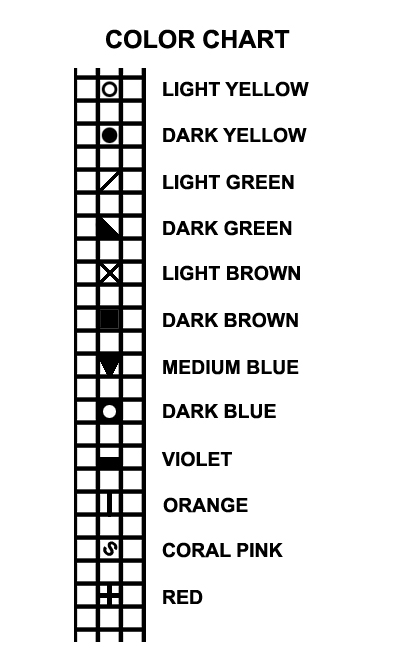
Doll Making | Clothespin Doll
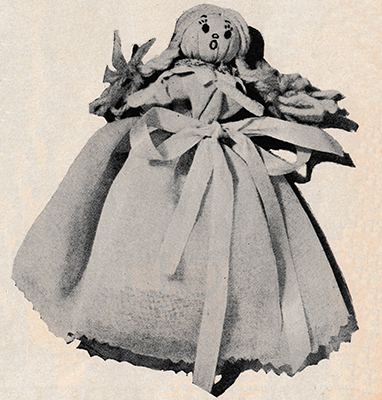
Katinka, the clothespin doll, is made in a twinkling. Saucy Katinka, the clothespin doll, has yellow yarn hair, a pink dress, and a flouncing organdy overskirt.
MATERIALS: Clothespin; pipe cleaner; pink cotton fabric for head and dress; organdy for overskirt; cotton for head padding; small piece of rickrack; yarn; ribbon; pen; black India ink.
DIRECTIONS: Pad top of clothespin; cover with pink fabric; wind with thread to fasten (Step 1). Wrap and twist pipe cleaner around clothespin for arms (Step 2). Lay strands of yarn, about 6" long, across a piece of paper to a width of about 1" (Step 3). Baste to paper, then stitch through center. Braid yarn, beginning about 1" from center stitching. Wind ends of braids with yarn to fasten. Remove paper and bastings. Sew hair to head all along top, tack to sides of cheeks (Step 4). Draw in face with pen and ink. Fold cloth for dress in half, crosswise; cut slit for neckline. Place dress on doll; sew side seams to armholes; gather neckline to fit doll. Cover neckline with rick-rack; tack at back. Cut two strips of organdy, about 3" x 11", for overskirt. Pink edges. Place pieces together (over-skirt is double thickness); gather to fit waistline; tack at back.
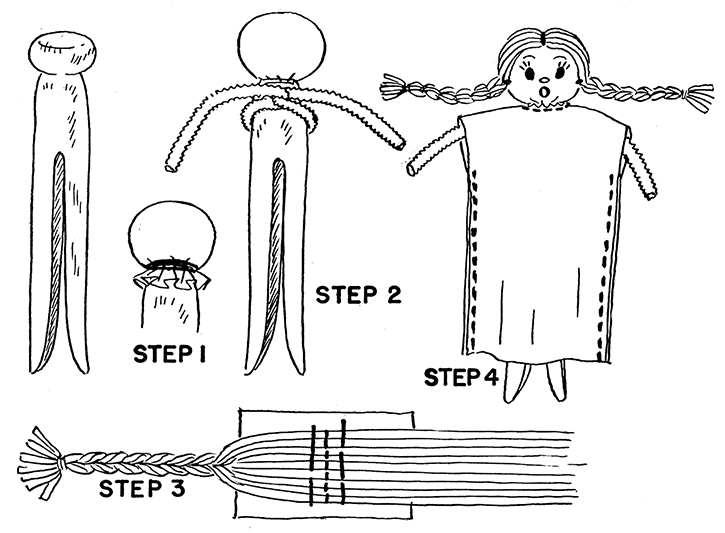
Doll Making | Two Papier-mâché Hand Puppets
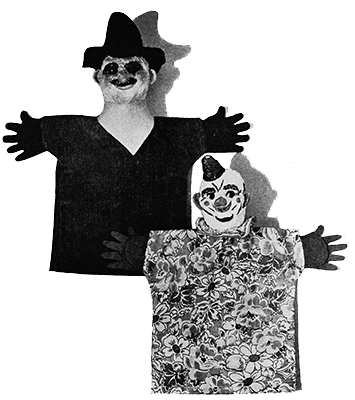
Playtime pals for children to make—two hand puppets, Tony the Organ Grinder and Toto the Clown, modeled from papier-mâché and dressed in scraps of felt, corduroy and printed cotton. Tony is ruddy-faced, beetle-browed, moustachioed—he wears a green corduroy shirt, yellow neckerchief, black hat, and red gloves. Toto’s merry face is white with red spots, black lines—he wears a green cap, gaily-printed shirt, and red gloves.
MATERIALS:
To Construct the Puppets: Newspaper; flour or wallpaper paste; deep pan; 2 soft-drink or similarly shaped bottles; 2 pieces of firm cotton cloth (such as sheeting) 5" or 6" square; 2 rubber bands; clay modeling tools (or flat kitchen or palette knife, orangewood stick, and larger stick rounded on the end); glue; tiny marbles, shoe buttons or similar type buttons for eyes (optional).
To Decorate the Puppets: Poster or enamel paints—white, yellow, red, black, brown and green; white shellac or colorless nail polish; brushes; denatured alcohol to clean shellac brush; a few strands of knitting worsted for hair, moustache, eyebrows, and whiskers (optional).
To Make Clothes: Scraps of sturdy fabric, such as percale or corduroy, for shirts; scraps of felt for hands and Tony's hat and neckerchief; ruffle for Toto's collar.
DIRECTIONS: Whole procedure, including drying, will take about a week.
To make Papier-mâché: Fold and tear two full sheets of newspaper in halves, then quarters, then eighths, then sixteenths. Shred these small squares, a few at a time, into strips about ½" x 6". Place in deep pan, cover with warm water, stir to loosen strips and let stand at least 24 hours, but preferably three days. When a wad, squeezed dry, holds its shape, paper is ready for mixing with paste. Mix about 1 cup of fairly thick paste for each head. Use about four or five handfuls of paper, squeezed as dry as possible, for one head. Put part of paste in a pie tin or other open pan. Tear apart wads of paper and mix thoroughly with paste. Success of the modeling depends on paste and paper being properly mixed. If mixture keeps falling apart you have either 1) left too much water in paper (re-squeeze it); 2) made paste too thin (add more flour); 3) used too much paste for amount of paper (add more paper); or 4) failed to mix paper and paste together sufficiently.
To Model Head: Center square of sheeting over top of bottle. Hold in place near bottom with a rubber band. (Some bottles are too gradually tapered for rubber band to stay in place. For such bottles, tie a piece of string loosely around sheeting near the bottle top.) This cloth stays inside the head permanently and should extend below the puppet's neck at least 1" all around. The dress is sewn to this extension.
Take a sizable ball of papier-mâché and push it down directly over top of bottle, forming an oval head and about ½" neck. Do not form neck too tightly around neck of bottle. Reinforce any weak spots with additional papier-mâché. With round-end stick, gently press in eye sockets about halfway down from top of head. Be careful not to punch them all the way through. Set in buttons, marbles or tiny rolled balls of papier-mâché for the eyeballs. With small pinches of papier-mâché, and using plenty of paste, attach ridges for eyebrows and lips; lumps for cheeks and chin; a nose and, finally, ears. It is easier to form ears before attaching them. Be sure to form them in opposite directions, making a left and a right ear. Shape and smooth entire head with modeling tools. Level base of neck with a knife. Check for, and reinforce, any weak spots—especially around eyes and ears. Be sure neck and top of head are thick enough not to break through. Add a cone shape for clown's hat.
Cover remaining papier-mâché mixture to keep it from drying out. Let head dry for several hours. Check again, and patch any weak spots or holes. Try easing head off bottle to stretch neck in case it has been formed too tightly around bottle. Mend any cracks this may cause.
Let puppet dry thoroughly in a warm place (but not over direct heat or in strong sunlight) for three or four days. Intense heat will shrivel and wrinkle puppet (fine for making an old wrinkled face). When outside feels dry, slip from bottle and lay head on its side to hasten drying of inside. When puppet is completely dry, inside and out, it is ready to be painted.
To Paint the Head: Be sure sheeting is securely attached to inside of head, adding paste or glue if it seems loose. Hold head on your finger while painting. Dry thoroughly between each coat of paint.
Paint Toto's head with two coats of white. Paint ears, mouth, dots on cheeks, and tip on nose red. Paint hat green. Paint eyebrows, eye pupils and lids, base of hat, and lines on face black. Paint a fringe of black hair around back hairline, beginning just behind the ears.
Paint Tony's head with one coat of white and one coat of flesh color (white mixed with a bit of red and yellow). Paint lower lip red. Tint ears, cheeks, and nose lightly with red. Paint eyebrows, eye sockets, and moustache brown. Paint eyeballs black. Paint a fringe of brown hair around back hairline.
Apply two coats of shellac or colorless nail polish to the dried puppets, taking care not to get any shellac on the cloth extension—difficult to sew through.
If you want to use yarn instead of paint for the hair, moustache, etc., comb out short lengths of yarn with a fine-toothed comb, cut to desired size, and arrange on puppet while the first coat of shellac is still quite sticky.
To Make the Clothes: For each puppet, cut two pieces of the shirt pattern from sturdy cotton; two full hand sections and two palm sections from scraps of felt. Turn under seam allowance at sleeve ends of shirt. Sew hands to sleeve ends of shirt back, thumbs up; palms to sleeve ends of front. Sew front and back of shirt together along shoulder and side seams, using flat or French seams on fabrics that ravel. Hem lower edge of shirt. Sew hand sections together around edge of palm. Turn under neck edge and whipstitch securely to cloth extension of head, as close to puppet's neck as possible. Cover clown's neck with a ruff, Tony's with a scarf.
Measure the circumference of Tony's head. Cut his hat brim and crown from scraps of black felt (see pattern diagram). Slash inside of brim, as shown, to fit head. Sew crown together along center back and top. Sew crown to brim over slashed edge. Glue hat to head. Shape brim.
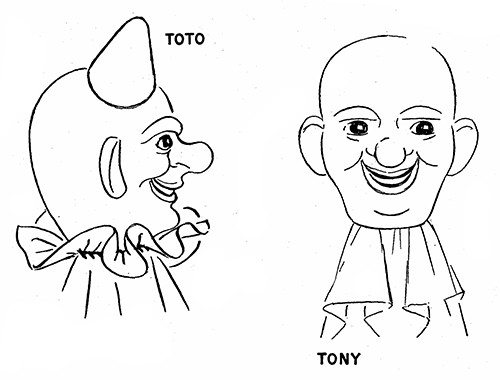
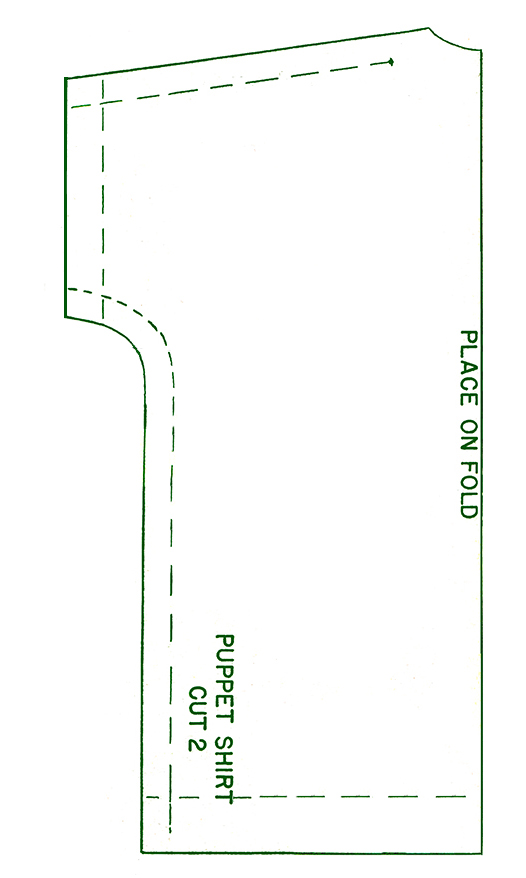
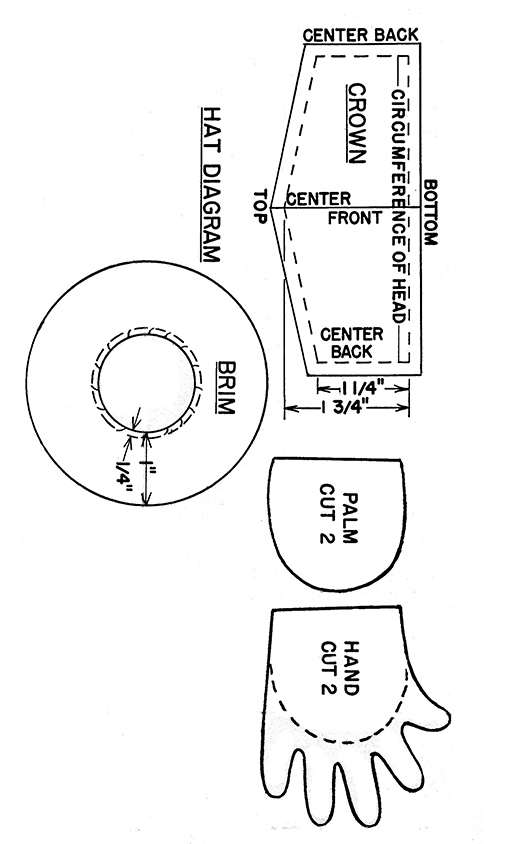
McCall's Needlework & Crafts Magazine | Annual Volume III
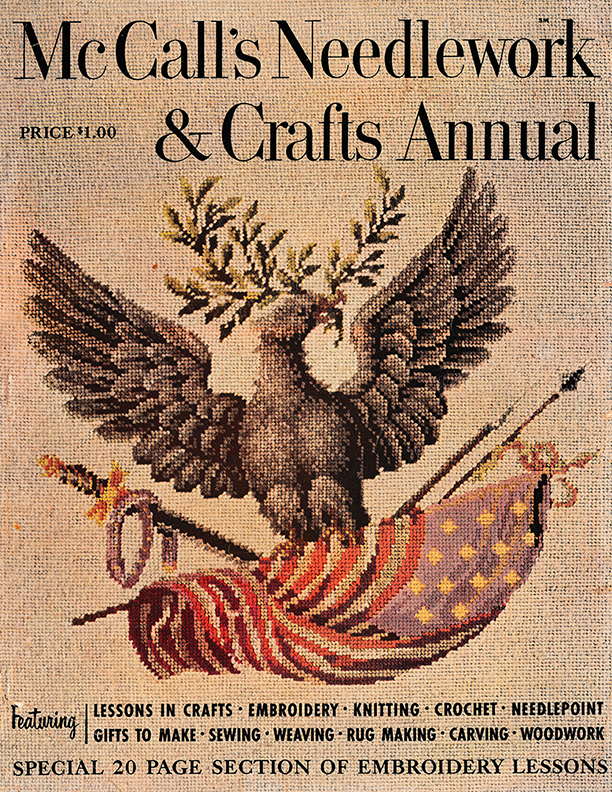
McCall's Needlework & Crafts Annual Magazine
Volume III
McCall Corporation
Original Copyright 1952
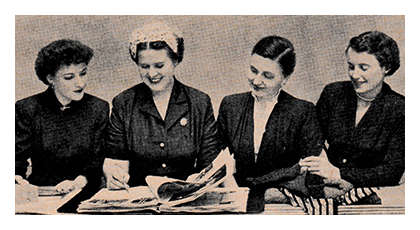 You readers may wonder how we put a magazine like this together. The first step is to obtain made-up items, complete with instructions for making, in as large a variety of handcrafts as possible.
You readers may wonder how we put a magazine like this together. The first step is to obtain made-up items, complete with instructions for making, in as large a variety of handcrafts as possible.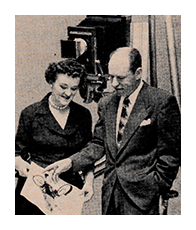 For a year or more we have been collecting material for this issue of Annual. Many of our own ideas were developed by expert artists and craftsmen who work with us. Most of the knitting and crochet, designed at our request, comes from large yarn and thread companies. Some of the material is submitted by readers. With the actual items in front of us, we pick, choose and balance,
For a year or more we have been collecting material for this issue of Annual. Many of our own ideas were developed by expert artists and craftsmen who work with us. Most of the knitting and crochet, designed at our request, comes from large yarn and thread companies. Some of the material is submitted by readers. With the actual items in front of us, we pick, choose and balance, 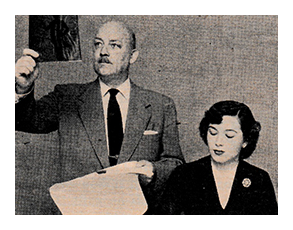 always wishing that we had more space to include everything on hand. Making plans, top (left to right) Eleanor Spencer, Nan Comstock, Gena Rhoades, and Jane Callaghan. Next, material is taken to the photographers by Alixe Scott and Dick Coe (above), who supervise details. Photographs in, pages are planned; then layouts made by Alex Sniffen and Alyce Murphy (above, left).
always wishing that we had more space to include everything on hand. Making plans, top (left to right) Eleanor Spencer, Nan Comstock, Gena Rhoades, and Jane Callaghan. Next, material is taken to the photographers by Alixe Scott and Dick Coe (above), who supervise details. Photographs in, pages are planned; then layouts made by Alex Sniffen and Alyce Murphy (above, left). 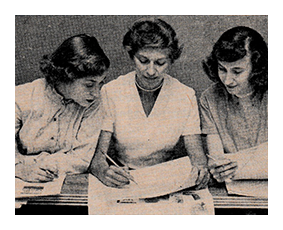 The writing is under the supervision of Amalia G. Casseres (not present when photographs were taken). Her assistants are (left to right) Carol Stein and Betsy Darrach, shown checking page proofs with my secretary, Claire Tetrault.
The writing is under the supervision of Amalia G. Casseres (not present when photographs were taken). Her assistants are (left to right) Carol Stein and Betsy Darrach, shown checking page proofs with my secretary, Claire Tetrault.
The Editor.
Nanina Comstock, Editor-in-Chief
McCall's Needlework and Crafts Annual III, © 1952
| PATTERN NAME | YARN | ORIG PUB |
| Embroider Flowers in Small Stitches | n/a | |
| Embroider Flowers with Variety | n/a | |
| Embroider on Ticking in Straight Lines | n/a | |
| Embroider in Cross Stitch | n/a | |
| Embroider an Eagle | n/a | |
| Embroider on Wire Screening | n/a | |
| Embroider in English Smocking on Pleats | n/a | |
| Embroider on Huck | n/a | |
| Embroider with Applique Rickrack, Braid and Tape | n/a | |
| Three-Piece Suit | Bernat | |
| Pot Holder | American Thread | |
| Cap and Mittens | American Thread | |
| Evening Blouse with Ribbon Yoke | Potomac | |
| Two-Piece Dress | Spinnerin | |
| Shoulderette | Nomotta | |
| Angora Bolero | Beehive | |
| Striped Slipon | Penguin | |
| Dolman-Sleeved Slipover | Seaspun | |
| Turtleneck Pullover | Fleisher's | |
| Cable Cardigan | Fleisher's | |
| Black Scarf | Botany | |
| Gauntlet Gloves | Fleisher's | |
| Plaid Socks | Minerva | |
| White Spencer | Spinnerin | |
| Cardigan and Mittens | Columbia | |
| Norwegian Cardigan | Fleisher's or Columbia | |
| Cable Slipon | Bishop's | |
| Girls' Cardigan | Beehive | |
| Cuffed Gloves | Sort Yarn | |
| Yellow Cable Socks | Spinnerin | |
| Skating Cap | Botany | |
| Santa Claus Mittens | Botany | |
| Braid-Trimmed Suit | Nomotta | |
| Men's Pullover | Penguin | |
| Sleeveless Pullover | Chadwick's Red Heart | |
| Men's Slipon | Bernat | |
| Boys' Cardigan | Bishop's | |
| Boys' Pullover | Botany | |
| Men's Pullover | Botany | |
| Four-Piece Outfit | Minerva | |
| Three-Piece Set | Botany | |
| Little Boy Blue Cardigan | Nomotta | |
| Nubby Pullover | Zelta | |
| Raglan Sleeve Cardigan | Seaspun | |
| Garter and Lace Stripe Cardigan | Columbia | |
| Argyle Pullover | Bear Brand | |
| Chenille Stole | Dritz | |
| American Beauty Stole | Bear Brand | |
| Drawstring Cap and Bag | American Thread | |
| Filet Washcloth | Crochet Thread | |
| Edging and Insertion | J.&P. Coats | |
| Hat and Bag | Dritz | |
| Brim Cloche | Fingering Yarn | |
| Resort Bag | Hiawatha | |
| Chenille Bag | Hiawatha | |
| Corde Bag | Hiawatha | |
| Afghan Sample | Knitted Worsted Yarn | |
| Daisy Dress | Fleisher's or Bear Brand | |
| Sequin Slippers | Bucilla | |
| Sequin Earmuffs | Knit-Cro-Sheen | |
| Sequin Crochet Belt | Lily Mills | |
| Sequin Crochet Apron | Bucilla | |
| Pigtail Cap | Knitted Worsted Yarn | |
| Jester Slippers | American Thread | |
| Duck Slippers | Chadwick's Red Heart | |
| Strapped Bootees | Nomotta | |
| Sweater and Cap | Lily Mills | |
| Carriage Robe | Lily Mills | |
| Bottle Holder | Bear Brand | |
| Lacy Tablecloth | American Thread | American Thread #28 |
| Sea Anemone Medallion | Peri-Lusta | |
| Maple Leaf Medallion | Lily Mills | |
| Rose Wheel Tablecloth | American Thread | |
| Oval Mat | Dritz | |
| Five-Piece Set | Bucilla | |
| Dogwood Set | Lily Mills | |
| Doily Set | Lily Mills | |
| Daisy Wheel Medallion | American Thread | |
| Tiny Motifs | Cartier Bresson | |
| Lace Scarf | American Thread | |
| Small Doily | J.&P. Coats | |
| Large Doily | J.&P. Coats | |
| Lucky Wheel Bedspread | American Thread | |
| Weather Vane Bedspread | American Thread | American Thread #11 |
| Six-Pointed Star Rug | Various | |
| Corner Edging #1 | Daisy | |
| Corner Edging #2 | Daisy | |
| Corner Edging #3 | Daisy | |
| Corner Edging #4 | Daisy | |
| Corner Edging #5 | Daisy | |
| Corner Edging #6 | Daisy | |
| Flower Rug | Bucilla | |
| Cake Pot Holder | American Thread | |
| Puff-Stitch Pot Holder | Lily Mills | |
| Oval Hot Plate Mat | Lily Mills | |
| Snowman Sachet | Crochet Cotton | |
| Party Snapper Sachet | Crochet Cotton | |
| Purse Sachet | Crochet Cotton | |
| Round Doily | DMC | |
| Wide Insertion | DMC | |
| Whimsical Lamp Shade Cut and Paste Paper Craft | n/a | Lesson 1 |
| Nursery Rhyme Shadow-Box Pictures Cut and Paste Paper Craft | n/a | Lesson 1 |
| Little Wooden Boxes Cut and Paste Paper Craft | n/a | Lesson 1 |
| Bold Peasant Stenciling Craft | n/a | Lesson 2 |
| Lily of the Valley Stenciling Craft | n/a | Lesson 2 |
| Sweet Pea Stenciling Craft | n/a | Lesson 2 |
| Chrysanthemum Stenciling Craft | n/a | Lesson 2 |
| Maple Leaf and Oak Leaf Stenciling Craft | n/a | Lesson 2 |
| Block Printing Craft | n/a | Lesson 3 |
| Raffia and Reed Craft | n/a | Lesson 4 |
| Leathercraft | n/a | Lesson 5 |
| Sawing and Whittling Craft | n/a | Lesson 6 |
| Painting Freehand Craft | n/a | Lesson 7 |
| China Painting Craft | n/a | Lesson 8 |
| Pottery Slab Method Craft | n/a | Lesson 9 |
| Freehand Bronzing | n/a | Lesson 10 |
| Salt and Starch for Modeling Craft | n/a | |
| Two Hand Puppets | n/a | Dollmaking |
| Tiny Clothespin Doll | n/a | Dollmaking |
| Cotton-stuffed Muslin Doll | n/a | Dollmaking |
| How to Enlarge Designs by Squares | n/a | How To |
| How to Make Working Tracings of Designs | n/a | How To |
| How to Mix Colors | n/a | How To |
| How to Draw an Oval | n/a | How To |
| How to Divide Any Line into Equal Parts | n/a | How To |
| Miniature Tole Pins and Earrings Craft | n/a | |
| Lamps and Shades Craft | n/a | |
| Traditional Rug Hooking | n/a | |
| Cookie Tree | n/a | |
| Carved Christmas Creche | n/a | |
| Woodwork Craft | n/a | |
| Mobiles Craft | n/a |
Doll Making | Cotton-Stuffed Muslin Doll

For a little girl's playtime
Slender, cotton-stuffed muslin doll—a quaint and charming playmate. Wired arms and legs make her an endlessly maneuverable, obligingly flexible companion for "make-believe." Dress her for everyday in a striped cotton frock and a perky pinafore—or, for parties, in a dotted Swiss dress and bonnet, saucily puffed and ribbon-trimmed. Lace edged organdy undies, white socks and wing-bowed felt shoes complete her wardrobe.
EQUIPMENT: Scissors; needle and thread; tissue paper; pencil; No. 1 knitting needle wrapped at tip with a bit of adhesive tape to blunt point; glass drinking straw, ¼" in diameter and about 2" shorter than knitting needle; toothpicks.
MATERIALS: for Doll's Body: ⅛ yd. 36" flesh-colored muslin; 2¼ ft. heavy, pliable wire; cotton for stuffing; small amounts of oil paints—red, brown, blue, white; 6" theatrical crepe hair or 6" lengths of yarn. (To curl yarn, wrap it around a matchstick or bobby pin; steam press. Let dry.)
For Clothes: Scraps of the following: old white socks or white rayon jersey for stockings; white felt for shoes; white organdy for panties, petticoat and pinafore; striped cotton for play dress and handbag; dotted Swiss for party dress and bonnet; matching ribbon for bonnet tie and dress sash; lace edging for panties and petticoat; narrow elastic. Snap fasteners.
DIRECTIONS:
Basic instructions to cut and sew: Patterns are given actual size for doll body and all clothes not cut as straight rectangular pieces. Trace all patterns onto tissue paper (see Tracing Instructions). Cut out and pin to fabric. Place FOLD line on folded fabric. Fold fabric on straight of goods. Seam allowance on doll body is ⅛", on all clothing except shoes, ¼"; on shoes, just enough to allow for whipstitching soles to uppers. Sew all seams on inside. Turn hem allowance to inside, slipstitch. To gather, use small running stitch.
Body: Cut two body sections. Trace and cut stencil for features from heavy paper. Paint face (Fig. 1), using toothpick for a paint brush. Eyebrows, nostrils, and outlines of eyes and mouth are brown; mouth is red; eyes are white with blue centers. Paint cheeks red, dabbing paint on lightly with a tiny piece of cotton. Sew front and back of body together, leaving opening at top of head for stuffing. Clip seam allowance as indicated. Turn right side out. Poke out arms and legs with blunted knitting needle inserted through glass drinking straw to make turning easier.
Cut wire 21" long for legs. Bend in half (Fig. 2), bend small loops at each end. Insert in doll. Stuff legs and body up to waist. Use small pieces of cotton (about 1" long) to prevent lumpiness. Use blunted knitting needle to push cotton solidly into body and around wires. Cut wire 10" long for arms, bend loops at ends (Fig. 3). Stuff arms, remaining body and head. Turn in raw edges of top opening; sew together. Bend up ends of legs ½" to make feet. Attach hair. Spread the 6" lengths of yarn or crepe hair to about 1" in width. Stitch through center (Fig. 4). Sew in place (Fig. 5).
Stockings: Cut piece of fabric about 2½" long, 1½" wide. Hem ¼" at top. Wrap around doll's leg, with bottom edge extending slightly over instep. Turn under raw edges at back; whipstitch together.
Shoes: Use patterns to cut soles, uppers and bows. Place uppers on doll's feet; whipstitch together up back of heel. Whipstitch soles to uppers. Tack bows to instep, stitching through foot to sole.
Panties: Cut piece of fabric 5" wide, 1¾" long. Fold in half, crosswise; sew side seam. Stitch a triangular crotch, ¾" deep and ½" wide at base (Fig. 6). Cut out as shown, leaving about x" seam allowance. Clip seam allowance, almost to stitching line, at point of triangle. Hem ¼" at leg openings and top, leaving small opening in top hem to insert elastic. Sew lace edging around leg openings. Cut piece of elastic to fit doll's waist; insert in top hem.
Petticoat: Cut piece of fabric 10" wide, 3" long. Fold in half, crosswise; sew back seam. Hem ¼" at top and bottom, leaving small opening in top hem to insert elastic. Sew lace edging to bottom. Cut piece of elastic to fit doll's waist; insert in top hem.
Dotted Swiss Dress: Cut piece of fabric 16" wide, 5" long. Fold in half, crosswise; sew back seam, leaving opening at top about 1½" long. Hem ½" at one edge for bottom of dress, hem ¼" at other edge for neckline. Cut ¾" lengthwise slits below neck hem on each side for armholes. Gather neckline to size of doll's neck. Cut two sleeves from pattern. Sew underarm seams of each sleeve. Hem ¼" at bottom edges. Seam sleeves to armholes, gathering to fit. Gather lower edges to size of arm. Make rolled hem around neck opening; sew snap fastener to top. Tie ribbon sash around waist.
Bonnet: Cut back section from pattern. Hem ¼" at neck edge. Fold under ¼" on remaining edge and run gathering thread around it. For brim, cut piece of fabric 5" long, 3½" wide. Fold in half, lengthwise; sew seams at ends. Turn right side out. Gather folded edge of back section to length of brim. Sew back section to brim, easing in gathers evenly all around (Fig. 7). Tack a ribbon bow to brim at X (Fig. 8). Gather bottom of back section to fit back of doll's neck. Sew ribbon tie to back of bonnet. Tie bow under chin.
Striped Dress: Front and back are cut in one piece. Cut from pattern, folding fabric both lengthwise and crosswise, making four thicknesses. Sew side seams to X. Cut 1½" slit in center back for neck opening; roll hem. Hem ¼" along bottom, neck and armholes. Gather neck and sleeves to fit doll. Sew snap fasteners to neck opening.
Pinafore: Cut bib top from pattern. Fold and hem neck edge as indicated. Hem ¼" along all other edges except bottom. For skirt, cut piece of fabric 2¼" wide, 9" long. Hem ¼" along one long edge and both short edges. For waistband, cut two pieces of fabric ¾" wide, ½" longer than waistline of doll. Hem both ends of both strips. Turn under and crease seam allowance along long edges. Gather raw edge of skirt to fit waistband. Topstitch one edge of one waistband strip over gathered skirt (Fig. 10), other edge over bib top. Slipstitch other waistband strip to inside of pinafore, wrong sides of strips together. Cut small square of fabric for a pocket. Hem one edge, turn under remaining edges and sew to skirt. Sew snap fastener on back of waistband. Sew shoulder straps to back of waistband.
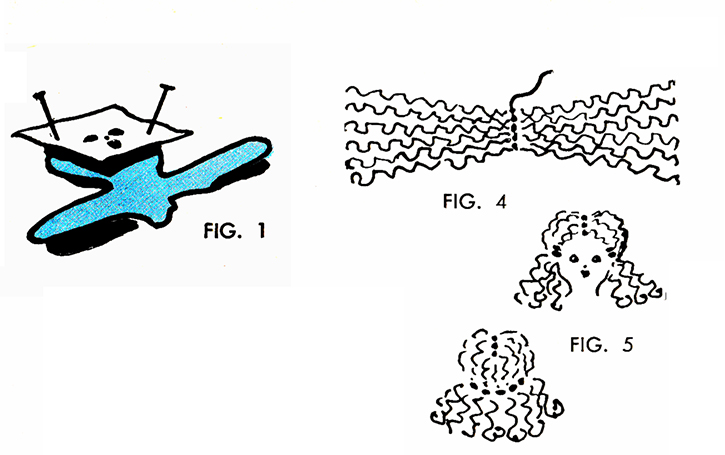

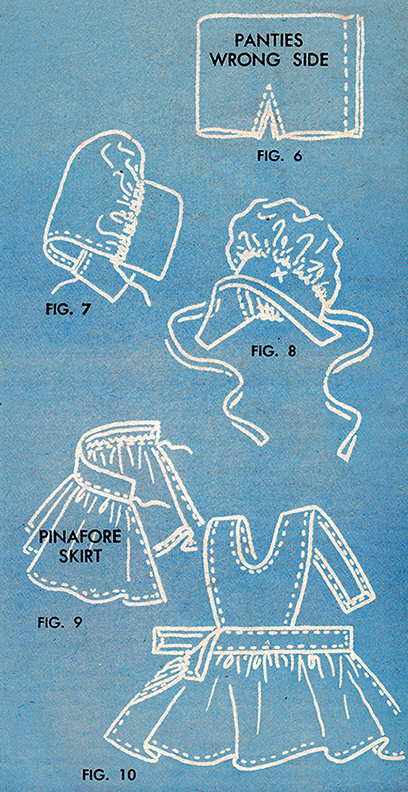
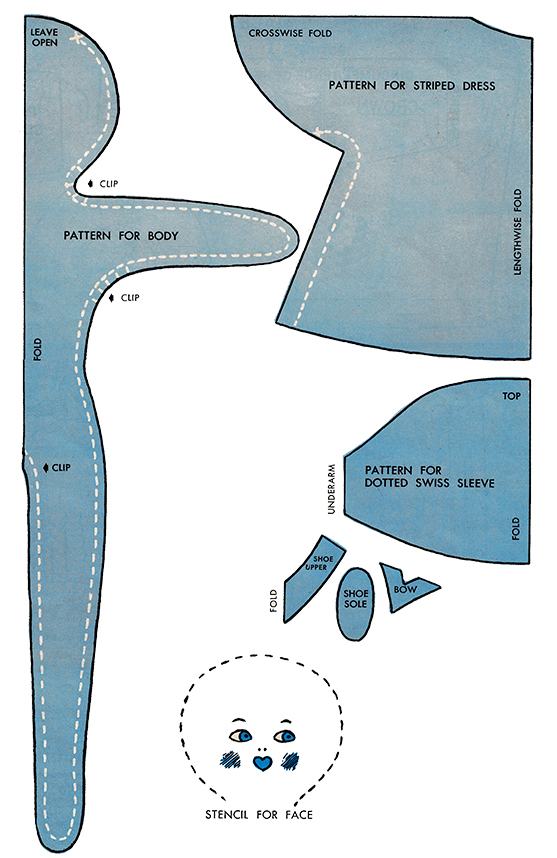
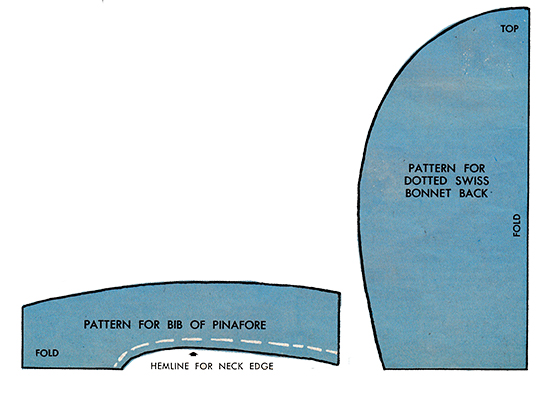
Maple Leaf and Oak Leaf Stenciling Craft
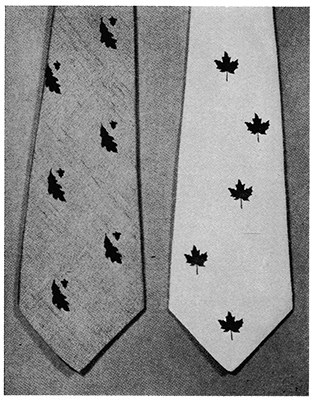
HOW TO STENCIL
MATERIALS:
EQUIPMENT: Sharp stencil-cutting tool or razor blade. Stencil paper—in small packages or large sheets. Stencil brushes— very stiff bristles and flat circular bottom. (No. 6 with ½" diameter good, or artists’ oil brushes with stiff bristles.) 2B drawing pencil. Textile paints, with directions for using and setting colors, usually a jar of extendor. Cleaning fluid—any reliable fabric cleaner—for cleaning brushes and stencil plates. Soft cotton rags. Desk-size white blotter. Right-angle triangle. Masking tape. Flat piece of glass on which to cut stencils, or Manila paper (cardboard makes knife stick).
Fabrics: All cottons, linens, rayons and silk. (Avoid rough weaves. It is hard to manipulate brush on them.) For washable articles, first remove all sizing by washing in lukewarm water and soapsuds, so color will not partially wash out.
Silks, chiffons and very fragile materials should be taped or pinned to a white blotter so they will not stick to stencil brushes. Heavy fabric need not be taped down. Unbleached cotton, Indian Head or mat side of chintz takes stenciling well. When stenciling garments, cut out first, stencil pieces separately, then sew.
Color of Fabrics: Textile colors, being transparent, are most effective used on light or medium backgrounds. If dark colored material is used, add white to colors to make them opaque. White does not penetrate fibre of fabric sufficiently to give secure anchorage, therefore will not be as washable as other colors.
HOW TO MAKE WORKING TRACINGS OF DESIGNS
Before using designs, they should be traced onto working sheets. Lay a sheet of tracing paper over page. Use a small amount of artist’s rubber cement, applied to each corner of tracing paper only, to hold it in place. Remove paper carefully. Rubber cement traces are easily rubbed away with fingertips. If rubber cement is not available, attach with small pieces of Scotch tape or masking tape. Tapes are difficult to remove. To avoid tearing page, cut the tape at edges of paper and leave tape on page.
WORKING PROCEDURE
Tracing: Place tracing sheet over white paper so lines will show clearly; then place on flat surface and tape to prevent slipping. Lay stencil paper over tracing. Tape. Trace, using pencil lightly. If you dig into stencil paper, both cut and printed edges will be fuzzy. Do not try to make lines black, just plain enough to see when cutting.
Cutting: Place stencil paper on glass or Manila envelope. Follow outlines with knife, cutting all the way through, so that cut shape will fall out easily. Knife should always point toward cut-out shape and be held at angle to obtain slightly beveled edge; this keeps paint from creeping under stencil edges when printing. Always cut toward you, that is, from top to bottom. Keep turning stencil paper around so that this is possible. Keep sharpening knife on moist sharpening stone.
Mixing Colors: Use plate, palette or any hard surface. Little color is needed. Amount on tip of knife will go a long way. Read directions carefully which come with stencil paints. Some textile paints need to be mixed with extendor, which is a necessary chemical ingredient. Never mix more paint than needed for painting at one time, as fabric paint dries rapidly.
Printing: Place fabric on white blotter. Tape. Lay stencil where you want it. Tape, or hold firmly with hand. Dig brush into color and rub off on piece of paper until almost dry. Work paint into fabric, through stencil openings, holding brush upright. With rotating motion, work from edge of opening toward center. Work color well into fabric. Do not load too much paint onto brush if you wish to make area solid. Better to repeat until entire area is covered. To shade, cover areas you wish to darken with other coats of paint.
Care of Stencils and Brushes: Do not wash stencils after using, as cleaning wears edges. Turn each stencil face down on blotter; with soft rag and a little cleaning fluid, gently wipe back clean. Store with sheet of paper between stencils.
Wash brushes in cleaning fluid; dry well. It is desirable to have a separate brush for each color. For example, a red brush may be used for all shades of red. Brushes should not be washed more than necessary. A little paint in bristles helps to keep them stiff.
Setting: Allow finished work to dry more than 24 hours and not more than 3 days. Then place fabric on ironing board, face up; cover with dry cloth and press for 3 minutes at 300° Fahrenheit, or at linen temperature on adjustable iron. Steam iron may be used. Turn material and press back with pressing cloth, dampened if desired. Fabrics which require a low heat should be set by pressing them a few minutes longer than directed above at a lower temperature.
TO STENCIL TIES
Cut a stencil for maple leaf or oak leaf and acorn, following directions. Print designs solid on silk ties in scatter effect or repeat designs.
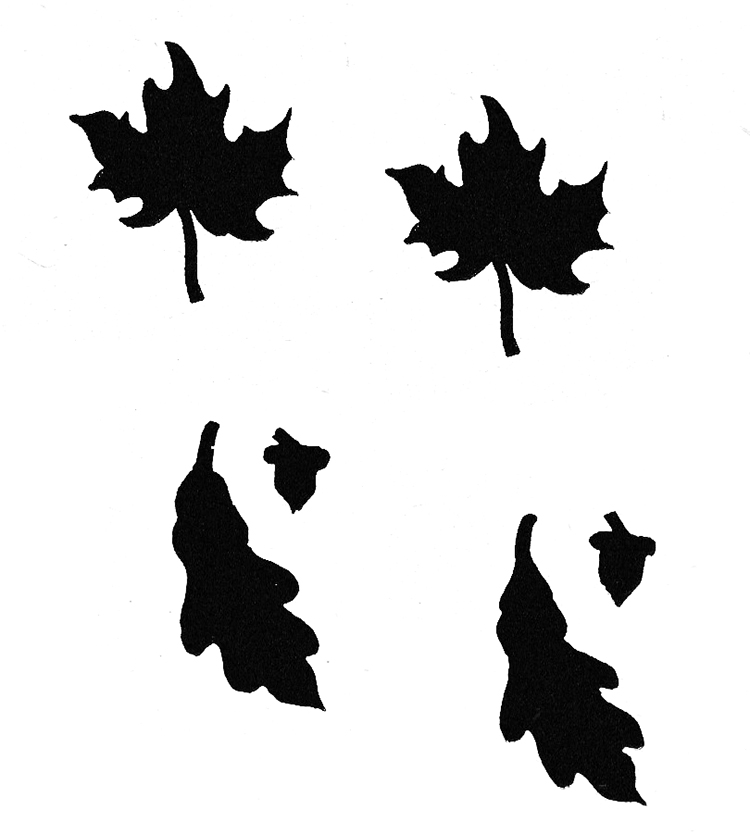
Chrysanthemum Stenciling Craft
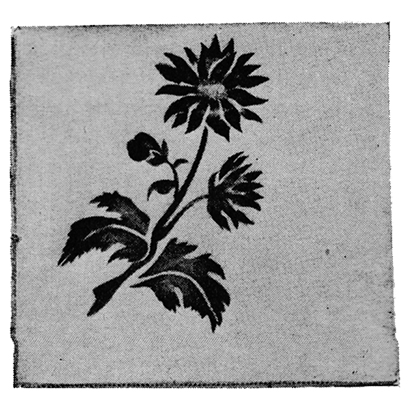
HOW TO STENCIL
MATERIALS:
EQUIPMENT: Sharp stencil-cutting tool or razor blade. Stencil paper—in small packages or large sheets. Stencil brushes— very stiff bristles and flat circular bottom. (No. 6 with ½" diameter good, or artists’ oil brushes with stiff bristles.) 2B drawing pencil. Textile paints, with directions for using and setting colors, usually a jar of extendor. Cleaning fluid—any reliable fabric cleaner—for cleaning brushes and stencil plates. Soft cotton rags. Desk-size white blotter. Right-angle triangle. Masking tape. Flat piece of glass on which to cut stencils, or Manila paper (cardboard makes knife stick).
Fabrics: All cottons, linens, rayons and silk. (Avoid rough weaves. It is hard to manipulate brush on them.) For washable articles, first remove all sizing by washing in lukewarm water and soapsuds, so color will not partially wash out.
Silks, chiffons and very fragile materials should be taped or pinned to a white blotter so they will not stick to stencil brushes. Heavy fabric need not be taped down. Unbleached cotton, Indian Head or mat side of chintz takes stenciling well. When stenciling garments, cut out first, stencil pieces separately, then sew.
Color of Fabrics: Textile colors, being transparent, are most effective used on light or medium backgrounds. If dark colored material is used, add white to colors to make them opaque. White does not penetrate fibre of fabric sufficiently to give secure anchorage, therefore will not be as washable as other colors.
HOW TO MAKE WORKING TRACINGS OF DESIGNS
Before using designs, they should be traced onto working sheets. Lay a sheet of tracing paper over page. Use a small amount of artist’s rubber cement, applied to each corner of tracing paper only, to hold it in place. Remove paper carefully. Rubber cement traces are easily rubbed away with fingertips. If rubber cement is not available, attach with small pieces of Scotch tape or masking tape. Tapes are difficult to remove. To avoid tearing page, cut the tape at edges of paper and leave tape on page.
WORKING PROCEDURE
Tracing: Place tracing sheet over white paper so lines will show clearly; then place on flat surface and tape to prevent slipping. Lay stencil paper over tracing. Tape. Trace, using pencil lightly. If you dig into stencil paper, both cut and printed edges will be fuzzy. Do not try to make lines black, just plain enough to see when cutting.
Cutting: Place stencil paper on glass or Manila envelope. Follow outlines with knife, cutting all the way through, so that cut shape will fall out easily. Knife should always point toward cut-out shape and be held at angle to obtain slightly beveled edge; this keeps paint from creeping under stencil edges when printing. Always cut toward you, that is, from top to bottom. Keep turning stencil paper around so that this is possible. Keep sharpening knife on moist sharpening stone.
Mixing Colors: Use plate, palette or any hard surface. Little color is needed. Amount on tip of knife will go a long way. Read directions carefully which come with stencil paints. Some textile paints need to be mixed with extendor, which is a necessary chemical ingredient. Never mix more paint than needed for painting at one time, as fabric paint dries rapidly.
Printing: Place fabric on white blotter. Tape. Lay stencil where you want it. Tape, or hold firmly with hand. Dig brush into color and rub off on piece of paper until almost dry. Work paint into fabric, through stencil openings, holding brush upright. With rotating motion, work from edge of opening toward center. Work color well into fabric. Do not load too much paint onto brush if you wish to make area solid. Better to repeat until entire area is covered. To shade, cover areas you wish to darken with other coats of paint.
Care of Stencils and Brushes: Do not wash stencils after using, as cleaning wears edges. Turn each stencil face down on blotter; with soft rag and a little cleaning fluid, gently wipe back clean. Store with sheet of paper between stencils.
Wash brushes in cleaning fluid; dry well. It is desirable to have a separate brush for each color. For example, a red brush may be used for all shades of red. Brushes should not be washed more than necessary. A little paint in bristles helps to keep them stiff.
Setting: Allow finished work to dry more than 24 hours and not more than 3 days. Then place fabric on ironing board, face up; cover with dry cloth and press for 3 minutes at 300° Fahrenheit, or at linen temperature on adjustable iron. Steam iron may be used. Turn material and press back with pressing cloth, dampened if desired. Fabrics which require a low heat should be set by pressing them a few minutes longer than directed above at a lower temperature.
HANDKERCHIEFS
GENERAL DIRECTIONS: Separate stencils must be cut for each symbol indicated by key given with designs. Sometimes shading is applied at edges with a second coat, as in the sweet pea design. Cut pink stencil, use same stencil for shading lavender at edge. Be sure to establish register angle on each stencil. Ascertain register angle on handkerchief and mark with masking tape.
Put first stencil in place and print. Continue with other stencils until design is completed.
Chrysanthemum: Cut 3 stencils following directions. Leaves are very light gray-green, shaded on edges with darker green or rust. Shade petals of flowers heavily on points and lighter toward center, using rust color. Center of flower is yellow-orange painted freehand. This design was worked on a pale yellow handkerchief.
FOLDERS FOR HANDKERCHIEFS: A folder to hold the stenciled handkerchief may be made with matching design on front. Use it as a birthday card.
Materials: Construction paper to match or contrast with color of handkerchief; white paper; textile paints; paste.
Print matching flower design on white paper, 3¾" x 4½", using stencils. Use textile paints or poster paints with very little paint on brush.
Fold a piece of colored construction paper 9" x 10½" in half, lengthwise. Use folded edge as bottom of card. Now fold crosswise so that folder opens from right to left. Fold down top left edge of inside page to center line to form a pocket for handkerchief. (See photograph).
Mount flower print on front of folder, pasting down on upper corners only. Write a birthday greeting on inside of folder. To make envelope, see diagram.
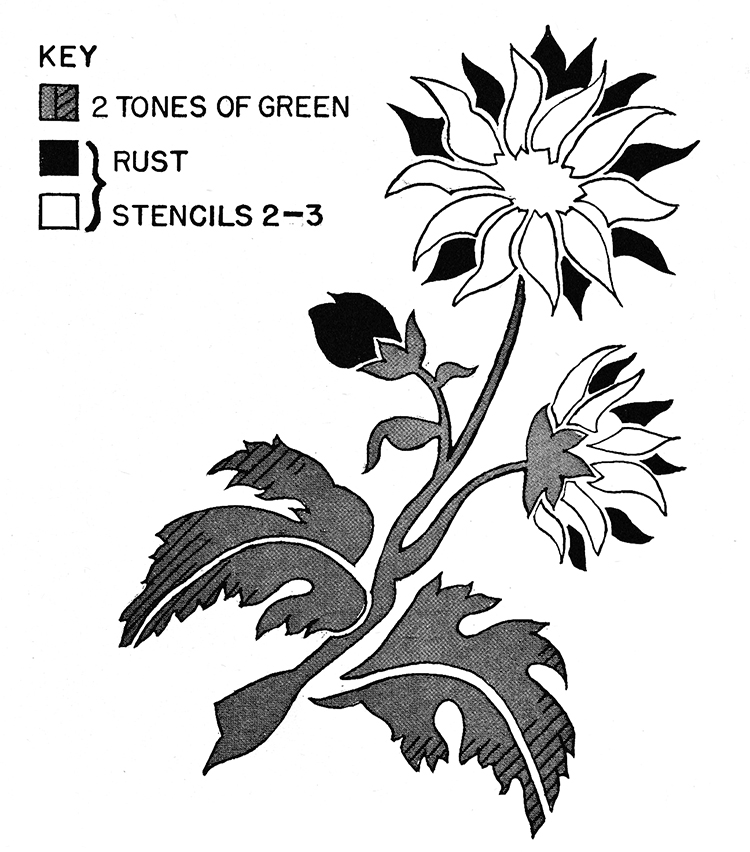
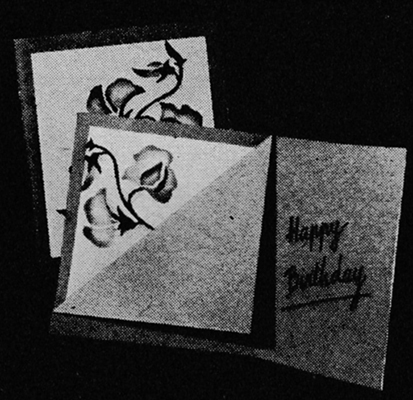
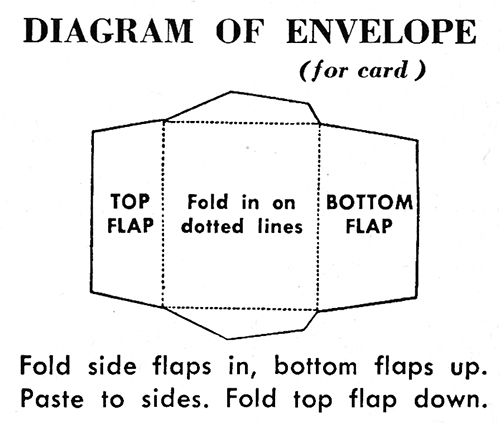
Sweet Pea Stenciling Craft
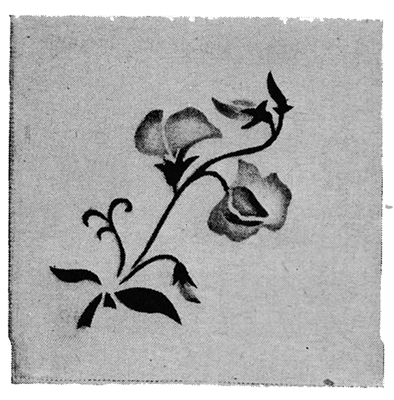
HOW TO STENCIL
MATERIALS:
EQUIPMENT: Sharp stencil-cutting tool or razor blade. Stencil paper—in small packages or large sheets. Stencil brushes— very stiff bristles and flat circular bottom. (No. 6 with ½" diameter good, or artists’ oil brushes with stiff bristles.) 2B drawing pencil. Textile paints, with directions for using and setting colors, usually a jar of extendor. Cleaning fluid—any reliable fabric cleaner—for cleaning brushes and stencil plates. Soft cotton rags. Desk-size white blotter. Right-angle triangle. Masking tape. Flat piece of glass on which to cut stencils, or Manila paper (cardboard makes knife stick).
Fabrics: All cottons, linens, rayons and silk. (Avoid rough weaves. It is hard to manipulate brush on them.) For washable articles, first remove all sizing by washing in lukewarm water and soapsuds, so color will not partially wash out.
Silks, chiffons and very fragile materials should be taped or pinned to a white blotter so they will not stick to stencil brushes. Heavy fabric need not be taped down. Unbleached cotton, Indian Head or mat side of chintz takes stenciling well. When stenciling garments, cut out first, stencil pieces separately, then sew.
Color of Fabrics: Textile colors, being transparent, are most effective used on light or medium backgrounds. If dark colored material is used, add white to colors to make them opaque. White does not penetrate fibre of fabric sufficiently to give secure anchorage, therefore will not be as washable as other colors.
HOW TO MAKE WORKING TRACINGS OF DESIGNS
Before using designs, they should be traced onto working sheets. Lay a sheet of tracing paper over page. Use a small amount of artist’s rubber cement, applied to each corner of tracing paper only, to hold it in place. Remove paper carefully. Rubber cement traces are easily rubbed away with fingertips. If rubber cement is not available, attach with small pieces of Scotch tape or masking tape. Tapes are difficult to remove. To avoid tearing page, cut the tape at edges of paper and leave tape on page.
WORKING PROCEDURE
Tracing: Place tracing sheet over white paper so lines will show clearly; then place on flat surface and tape to prevent slipping. Lay stencil paper over tracing. Tape. Trace, using pencil lightly. If you dig into stencil paper, both cut and printed edges will be fuzzy. Do not try to make lines black, just plain enough to see when cutting.
Cutting: Place stencil paper on glass or Manila envelope. Follow outlines with knife, cutting all the way through, so that cut shape will fall out easily. Knife should always point toward cut-out shape and be held at angle to obtain slightly beveled edge; this keeps paint from creeping under stencil edges when printing. Always cut toward you, that is, from top to bottom. Keep turning stencil paper around so that this is possible. Keep sharpening knife on moist sharpening stone.
Mixing Colors: Use plate, palette or any hard surface. Little color is needed. Amount on tip of knife will go a long way. Read directions carefully which come with stencil paints. Some textile paints need to be mixed with extendor, which is a necessary chemical ingredient. Never mix more paint than needed for painting at one time, as fabric paint dries rapidly.
Printing: Place fabric on white blotter. Tape. Lay stencil where you want it. Tape, or hold firmly with hand. Dig brush into color and rub off on piece of paper until almost dry. Work paint into fabric, through stencil openings, holding brush upright. With rotating motion, work from edge of opening toward center. Work color well into fabric. Do not load too much paint onto brush if you wish to make area solid. Better to repeat until entire area is covered. To shade, cover areas you wish to darken with other coats of paint.
Care of Stencils and Brushes: Do not wash stencils after using, as cleaning wears edges. Turn each stencil face down on blotter; with soft rag and a little cleaning fluid, gently wipe back clean. Store with sheet of paper between stencils.
Wash brushes in cleaning fluid; dry well. It is desirable to have a separate brush for each color. For example, a red brush may be used for all shades of red. Brushes should not be washed more than necessary. A little paint in bristles helps to keep them stiff.
Setting: Allow finished work to dry more than 24 hours and not more than 3 days. Then place fabric on ironing board, face up; cover with dry cloth and press for 3 minutes at 300° Fahrenheit, or at linen temperature on adjustable iron. Steam iron may be used. Turn material and press back with pressing cloth, dampened if desired. Fabrics which require a low heat should be set by pressing them a few minutes longer than directed above at a lower temperature.
HANDKERCHIEFS
GENERAL DIRECTIONS: Separate stencils must be cut for each symbol indicated by key given with designs. Sometimes shading is applied at edges with a second coat, as in the sweet pea design. Cut pink stencil, use same stencil for shading lavender at edge. Be sure to establish register angle on each stencil. Ascertain register angle on handkerchief and mark with masking tape.
Put first stencil in place and print. Continue with other stencils until design is completed.
Sweet Pea: Cut 3 stencils following directions. White handkerchief was used. Print leaves first, using fairly dark green textile paint, or use lighter green and shade darker on edges of leaves and tendrils. Print flowers and buds shades of pink and lavender, shading darker along edge of inside petals and buds.
FOLDERS FOR HANDKERCHIEFS: A folder to hold the stenciled handkerchief may be made with matching design on front. Use it as a birthday card.
Materials: Construction paper to match or contrast with color of handkerchief; white paper; textile paints; paste.
Print matching flower design on white paper, 3¾" x 4½", using stencils. Use textile paints or poster paints with very little paint on brush.
Fold a piece of colored construction paper 9" x 10½" in half, lengthwise. Use folded edge as bottom of card. Now fold crosswise so that folder opens from right to left. Fold down top left edge of inside page to center line to form a pocket for handkerchief. (See photograph).
Mount flower print on front of folder, pasting down on upper corners only. Write a birthday greeting on inside of folder. To make envelope, see diagram.
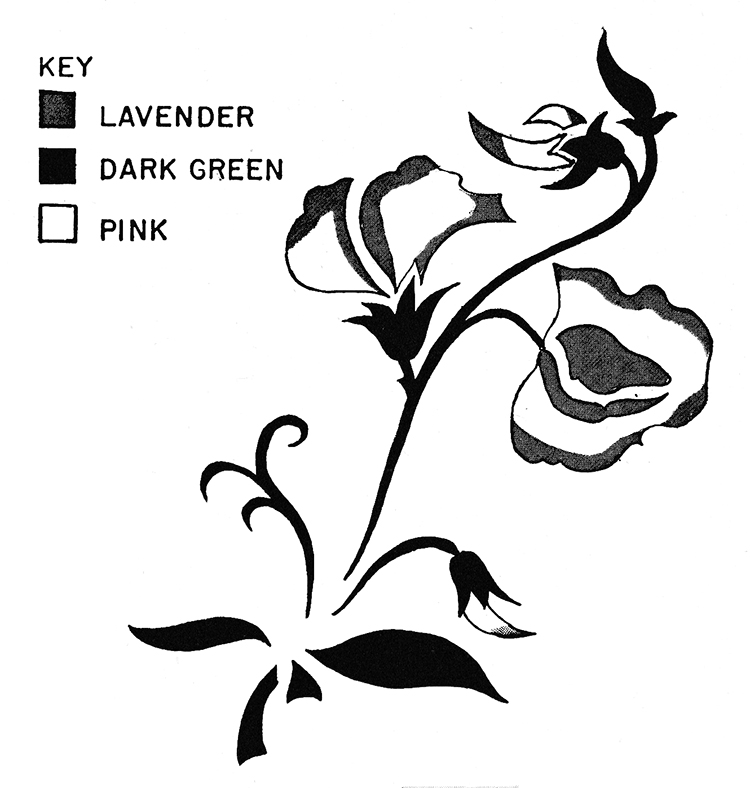

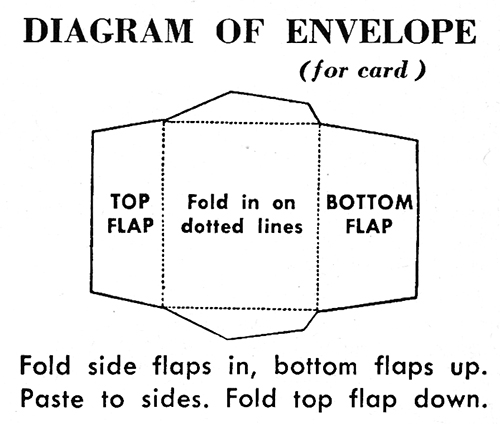
Lily of the Valley Stenciling Craft
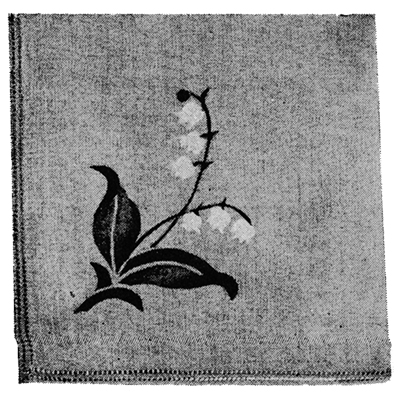
HOW TO STENCIL
MATERIALS:
EQUIPMENT: Sharp stencil-cutting tool or razor blade. Stencil paper—in small packages or large sheets. Stencil brushes— very stiff bristles and flat circular bottom. (No. 6 with ½" diameter good, or artists’ oil brushes with stiff bristles.) 2B drawing pencil. Textile paints, with directions for using and setting colors, usually a jar of extendor. Cleaning fluid—any reliable fabric cleaner—for cleaning brushes and stencil plates. Soft cotton rags. Desk-size white blotter. Right-angle triangle. Masking tape. Flat piece of glass on which to cut stencils, or Manila paper (cardboard makes knife stick).
Fabrics: All cottons, linens, rayons and silk. (Avoid rough weaves. It is hard to manipulate brush on them.) For washable articles, first remove all sizing by washing in lukewarm water and soapsuds, so color will not partially wash out.
Silks, chiffons and very fragile materials should be taped or pinned to a white blotter so they will not stick to stencil brushes. Heavy fabric need not be taped down. Unbleached cotton, Indian Head or mat side of chintz takes stenciling well. When stenciling garments, cut out first, stencil pieces separately, then sew.
Color of Fabrics: Textile colors, being transparent, are most effective used on light or medium backgrounds. If dark colored material is used, add white to colors to make them opaque. White does not penetrate fibre of fabric sufficiently to give secure anchorage, therefore will not be as washable as other colors.
HOW TO MAKE WORKING TRACINGS OF DESIGNS
Before using designs, they should be traced onto working sheets. Lay a sheet of tracing paper over page. Use a small amount of artist’s rubber cement, applied to each corner of tracing paper only, to hold it in place. Remove paper carefully. Rubber cement traces are easily rubbed away with fingertips. If rubber cement is not available, attach with small pieces of Scotch tape or masking tape. Tapes are difficult to remove. To avoid tearing page, cut the tape at edges of paper and leave tape on page.
WORKING PROCEDURE
Tracing: Place tracing sheet over white paper so lines will show clearly; then place on flat surface and tape to prevent slipping. Lay stencil paper over tracing. Tape. Trace, using pencil lightly. If you dig into stencil paper, both cut and printed edges will be fuzzy. Do not try to make lines black, just plain enough to see when cutting.
Cutting: Place stencil paper on glass or Manila envelope. Follow outlines with knife, cutting all the way through, so that cut shape will fall out easily. Knife should always point toward cut-out shape and be held at angle to obtain slightly beveled edge; this keeps paint from creeping under stencil edges when printing. Always cut toward you, that is, from top to bottom. Keep turning stencil paper around so that this is possible. Keep sharpening knife on moist sharpening stone.
Mixing Colors: Use plate, palette or any hard surface. Little color is needed. Amount on tip of knife will go a long way. Read directions carefully which come with stencil paints. Some textile paints need to be mixed with extendor, which is a necessary chemical ingredient. Never mix more paint than needed for painting at one time, as fabric paint dries rapidly.
Printing: Place fabric on white blotter. Tape. Lay stencil where you want it. Tape, or hold firmly with hand. Dig brush into color and rub off on piece of paper until almost dry. Work paint into fabric, through stencil openings, holding brush upright. With rotating motion, work from edge of opening toward center. Work color well into fabric. Do not load too much paint onto brush if you wish to make area solid. Better to repeat until entire area is covered. To shade, cover areas you wish to darken with other coats of paint.
Care of Stencils and Brushes: Do not wash stencils after using, as cleaning wears edges. Turn each stencil face down on blotter; with soft rag and a little cleaning fluid, gently wipe back clean. Store with sheet of paper between stencils.
Wash brushes in cleaning fluid; dry well. It is desirable to have a separate brush for each color. For example, a red brush may be used for all shades of red. Brushes should not be washed more than necessary. A little paint in bristles helps to keep them stiff.
Setting: Allow finished work to dry more than 24 hours and not more than 3 days. Then place fabric on ironing board, face up; cover with dry cloth and press for 3 minutes at 300° Fahrenheit, or at linen temperature on adjustable iron. Steam iron may be used. Turn material and press back with pressing cloth, dampened if desired. Fabrics which require a low heat should be set by pressing them a few minutes longer than directed above at a lower temperature.
HANDKERCHIEFS
GENERAL DIRECTIONS: Separate stencils must be cut for each symbol indicated by key given with designs. Sometimes shading is applied at edges with a second coat, as in the sweet pea design. Cut pink stencil, use same stencil for shading lavender at edge. Be sure to establish register angle on each stencil. Ascertain register angle on handkerchief and mark with masking tape.
Put first stencil in place and print. Continue with other stencils until design is completed.
Lily of the Valley: Cut 3 stencils following directions. Design is in green and white on pale green or chartreuse handkerchief. Print leaves first using light green (mix green with a little red and lighten with white and yellow). Shade darker for stems. Flowers are white or cream.
FOLDERS FOR HANDKERCHIEFS: A folder to hold the stenciled handkerchief may be made with matching design on front. Use it as a birthday card.
Materials: Construction paper to match or contrast with color of handkerchief; white paper; textile paints; paste.
Print matching flower design on white paper, 3¾" x 4½", using stencils. Use textile paints or poster paints with very little paint on brush.
Fold a piece of colored construction paper 9" x 10½" in half, lengthwise. Use folded edge as bottom of card. Now fold crosswise so that folder opens from right to left. Fold down top left edge of inside page to center line to form a pocket for handkerchief. (See photograph).
Mount flower print on front of folder, pasting down on upper corners only. Write a birthday greeting on inside of folder. To make envelope, see diagram.
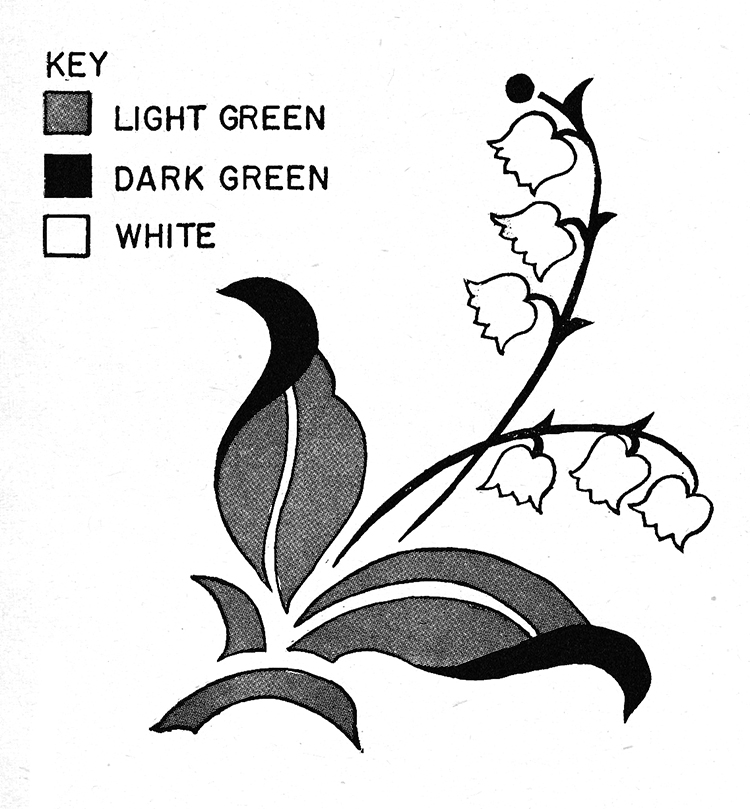
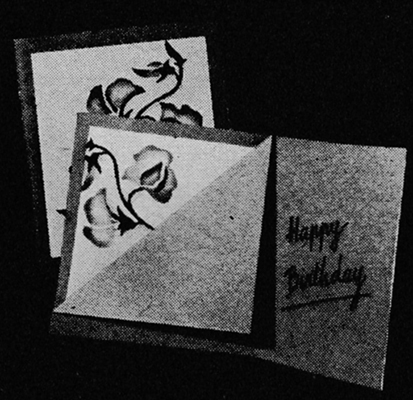
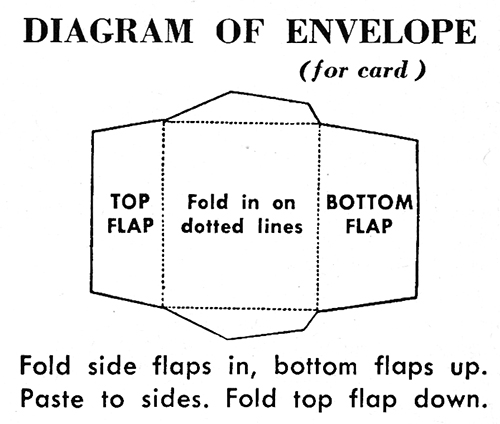
| Pattern Categories Browse the categories to help you find the patterns you're looking for. |
||













